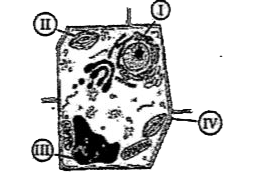Plant and animal cell are an example of:
Prokaryotic cells
Eukaryotic cells
Singular cells
None of the above
The correct Answer is:B
Step-by-Step Solution:
1. Understanding the Question: The question asks about the classification of plant and animal cells. We need to determine what type of cells they are examples of.
2. Identifying Cell Types: There are two main types of cells: prokaryotic and eukaryotic. Prokaryotic cells are simpler and do not have a true nucleus or membrane-bound organelles, while eukaryotic cells are more complex and contain a true nucleus and various organelles.
3. Analyzing Plant and Animal Cells: Both plant and animal cells are complex and contain a true nucleus and various organelles such as mitochondria, endoplasmic reticulum, and Golgi apparatus. This indicates that they are eukaryotic cells.
4. Evaluating the Options:
- Prokaryotic Cell: This option is incorrect because prokaryotic cells are typically bacteria and do not have a true nucleus.
- Eukaryotic Cell: This option is correct as both plant and animal cells are classified as eukaryotic cells.
- Singular Cell: This option is incorrect because "singular cell" refers to unicellular organisms, while plant and animal cells are part of multicellular organisms.
- None of the Above: This option is also incorrect since we have identified the correct classification.
5. Conclusion: Based on the analysis, the correct answer is that plant and animal cells are examples of eukaryotic cells.
Final Answer: Plant and animal cells are an example of eukaryotic cells.
---
- Prokaryotic Cell: This option is incorrect because prokaryotic cells are typically bacteria and do not have a true nucleus.
- Eukaryotic Cell: This option is correct as both plant and animal cells are classified as eukaryotic cells.
- Singular Cell: This option is incorrect because "singular cell" refers to unicellular organisms, while plant and animal cells are part of multicellular organisms.
- None of the Above: This option is also incorrect since we have identified the correct classification.
Topper's Solved these Questions
- BOOK - AGRAWAL EXAM CART BIHARCHAPTER - CELL STRUCTURE AND FUNCTIONSEXERCISE - Important Question44videos
CELL STRUCTURE AND FUNCTIONS
- BOOK - AGRAWAL EXAM CART BIHARCHAPTER - ASEXUAL AND SEXUAL REPRODUCTIONEXERCISE - IMPORTANT QUESTIONS48videos
ASEXUAL AND SEXUAL REPRODUCTION
- BOOK - AGRAWAL EXAM CART BIHARCHAPTER - CONSERVATION OF PLANTS AND ANIMALS (BIOSPHERE RESERVES, NATIONAL PARKS AND WILDLIFE SANCTURAIES)EXERCISE - Important Questions47videos
CONSERVATION OF PLANTS AND ANIMALS (BIOSPHERE RESERVES, NATIONAL PARKS AND WILDLIFE SANCTURAIES)
Similar Questions
Knowledge Check
- Question 1 - Select One
Plant and animal cell divisions differ in
ACell plateBProphaseCTelophaseDMetaphase - Question 2 - Select One
Plant and animal cell divisions differ in
Acell plateBprophaseCtelophaseDmetaphase - Question 3 - Select One
Vacuole is cell structure present in both plant and animal cells. Which of the following statements about plant and the animal cell vacuoles is true?
AThe plant cell has many small vacuoles, but the animal cell has one large vacuoleBThe plant cell has one large vacuole, but the animal cell has many small vacuoles.CThe plant as well as the animal cell has many small vacuoles.DThe plant as well as the animal cell has one large vacuole.
difference between plant cell and animal cell|| Cell wall
View SolutionA plant cell with four labeled portions is depicted in the given figure.

The labeled organelle present in both animal cell and plant cell isView SolutionName the two cellular components that are absent in an animal cell but present in the plant cell.
View SolutionAs compared to plant cells, animal cells are found in a variety of shapes. Animal cells are found in a verity of shapes because of the presence of a flexible
View SolutionIn plant and animal cells, chromatids or chromatin are made up of :-
View Solution

